A.R. Jung's Blog, page 2
December 2, 2020
Mythological Creature; Anzu, a Sumerian (first civilization) lion, eagle hybrid who breathes fire and water- Son of BEER demon Siris
 Photo Credit: https://tinyurl.com/y3y6ekz7
Photo Credit: https://tinyurl.com/y3y6ekz7According to History.com, Sumer was an ancient civilization founded in the Mesopotamian region of the Fertile Crescent situated between the Tigris and Euphrates rivers. Known for their innovations in language, governance, architecture and more, Sumerians are considered the creators of civilization as modern humans understand it. Their control of the region lasted for a short 2,000 years. The Babylonians took over in 2004 B.C.
 Photo Credit: https://tinyurl.com/7tbh6nt
Photo Credit: https://tinyurl.com/7tbh6ntThe Anzû, (see long list of Heraldic Griffin) is also known as dZû and Im-dugud.
According to Wikipedia, he is described as a lesser divine creature or monster in several Mesopotamian religions. He was conceived by the pure waters of the Apsu (which was the name of the fresh water, which came from underground aquifers and was believed to have given a religious fertilizing quality in Sumerian and Akkadian mythology.) Anzu is also described as being conceived of the wide Earth, and also as being the son of Siris.
The Anzu’s Appearance
 Photo Credit: Griffin -https://tinyurl.com/yxf9sejg
Photo Credit: Griffin -https://tinyurl.com/yxf9sejgAnzû is depicted as a massive bird who can breathe fire and water, although Anzû is alternately depicted as a lion-headed eagle. This creature predates all of the other griffin like creatures in modern mythology. See the list below for similar creatures and for hybrid creatures. This list is taken from Wikipedia.
Asakku, similar Mesopotamian deityGriffin or griffon, lion-bird hybridLamassu, Assyrian deity, bull/lion-eagle-human hybridZiz, giant griffin-like bird in Jewish mythologyZuism, Icelander protest against tax for religionHybrid creatures in mythologyList of hybrid creatures in mythologyTiamatCheck out the long list of creatures and heraldry the Anzu could be attributed to giving rise to here.
Connection to Beer Culture?
 Photo Credit: https://tinyurl.com/y5tqqppt
Photo Credit: https://tinyurl.com/y5tqqpptAn interesting tidbit; Anzu, as was mentioned, was said to be the son of Siris. The Mesopotamian goddess according to Wikipedia, was the patron of beer who was conceived of as a demon. She is said to be the daughter of the goddess Ninkasi.
Beer as we know it had its origins in Mesopotamia, and fermented beverages spread throughout the world from the region as the drink was shared with mighty kings and rulers.
The Epic of Gilgamesh
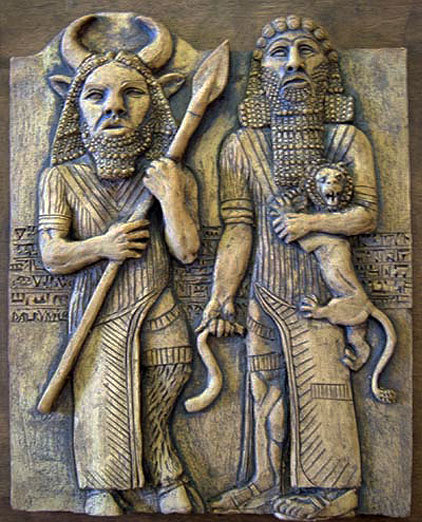 Photo Credit: https://tinyurl.com/y5ahpdp6
Photo Credit: https://tinyurl.com/y5ahpdp6According to History.com, the very first ruling body of Sumer having historical verification is the First Dynasty of Kish. The earliest ruler mentioned is Etana of Kish, who, in a document from that time, is credited as having “stabilized all the lands.” One thousand years later, Etana would be memorialized in a poem that told of his adventures in heaven. The most famous of the early Sumerian rulers is Gilgamesh, king of Uruk, who took control around 2700 B.C. and is still remembered for his fictional adventures in the Epic of Gilgamesh. This was the first epic poem in history and inspiration for later Roman and Greek myths and Biblical stories. A devastating flood in the region was used as a pivotal point in the epic poem and later reused in the Old Testament story of Noah? Read The Epic of Gilgamesh here on ancienttexts.org
Read on if you would like to know more about the Sumerians..

The Great Flood
 Photo Credit: http://p96890uu.beget.tech/classroom/53-noah-vs-gilgamesh-essay.html
Photo Credit: http://p96890uu.beget.tech/classroom/53-noah-vs-gilgamesh-essay.htmlAccording to Wikipedia, the Sumerian creation myth contains a great flood story and an ark.
The earliest record of a Sumerian creation myth, called The Eridu Genesis by historian Thorkild Jacobsen, is found on a single fragmentary tablet and was excavated in Nippur.
It is written in the Sumerian language and dated to around 1600 BC. Other Sumerian creation myths from around this date are called the Barton Cylinder, the Debate between sheep and grain and the Debate between Winter and Summer, also found at Nippur. The beginning of the tablet is lost, but at the point of the story where the surviving portion begins, it describes how the gods An, Enlil, Enki and Ninhursanga created the Sumerians and the comfortable conditions for the animals to live and procreate. Kingship then descended from heaven, and the first cities were founded: Eridu, Bad-tibira, Larak, Sippar, and Shuruppak.
After a missing section in the tablet, we learn that the gods have decided not to save mankind from an impending flood. Zi-ud-sura, the king and gudug priest, learns of this. In the later Akkadian version recorded in the Atra-Hasis Epic, Ea, or Enki in Sumerian, the god of the waters, warns the hero (Atrahasis in this case) and gives him instructions for building an ark. This is missing in the Sumerian fragment, but a mention of Enki taking counsel with himself suggests that this is Enki’s role in the Sumerian version as well.
Sumerian Civilization
 Photo Credit: https://tinyurl.com/c55nfq
Photo Credit: https://tinyurl.com/c55nfqThe following is according to History.com. Sumer was first settled by humans from 4500 to 4000 B.C., though it is probable that some settlers arrived much earlier.
This early population—known as the Ubaid people—was notable for strides in the development of civilization such as farming and raising cattle, weaving textiles, working with carpentry and pottery and even enjoying beer. Villages and towns were built around Ubaid farming communities.
The people known as Sumerians were in control of the area by 3000 B.C. Their culture was comprised of a group of city-states, including Eridu, Nippur, Lagash, Kish, Ur and the very first true city, Uruk. At its peak around 2800 BC, the city had a population between 40,000 and 80,000 people living between its six miles of defensive walls, making it a contender for the largest city in the world.
Each city-state of Sumer was surrounded by a wall, with villages settled just outside and distinguished by the worship of local deities.
Sumerian Language And Literature
 Photo Credit: https://tinyurl.com/y472pmoh
Photo Credit: https://tinyurl.com/y472pmohThe Sumerian language is the oldest linguistic record. It first appeared in archaeological records around 3100 B.C. and dominated Mesopotamia for the next thousand years. It was mostly replaced by Akkadian around 2000 B.C. but held on as a written language in cuneiform for another 2,000 years.
Cuneiform, which is used in pictographic tablets, appeared as far back as 4000 B.C., but was later adapted into Akkadian, and expanded even further outside of Mesopotamia beginning in 3000 B.C.
Writing remains one of the most important cultural achievements of the Sumerians, allowing for meticulous record keeping from rulers down to farmers and ranchers. The oldest written laws date back to 2400 B.C. in the city of Ebla, where the Code of Er-Nammu was written on tablets.
The Sumerians were considered to have a rich body of literary works, though only fragments of these documents exist.
Sumerian Art and Architecture
 Photo Credit: Ziggurat https://tinyurl.com/y6thn4ca
Photo Credit: Ziggurat https://tinyurl.com/y6thn4caArchitecture on a grand scale is generally credited to have begun under the Sumerians, with religious structures dating back to 3400 B.C., although it appears that the basics of the structures began in the Ubaid period as far back as 5200 B.C. and were improved upon through the centuries. Homes were made from mud bricks or bundled marsh reeds. The buildings are noted for their arched doorways and flat roofs.
Elaborate construction, such as terra cotta ornamentation with bronze accents, complicated mosaics, imposing brick columns and sophisticated mural paintings all reveal the society’s technical sophistication.
Sculpture was used mainly to adorn temples and offer some of the earliest examples of human artists seeking to achieve some form of naturalism in their figures. Facing a scarcity of stone, Sumerians made leaps in metal-casting for their sculpture work, though relief carving in stone was a popular art form.
Under the Akkadian dynasty, sculpture reached new heights, as evidenced by intricate and stylized work in diorite dated to 2100 B.C.
Ziggurats began to appear around 2200 B.C. These impressive pyramid-like, stepped temples, which were either square or rectangular, featured no inner chambers and stood about 170 feet high. Ziggurats often featured sloping sides and terraces with gardens. The Hanging Gardens of Babylon was one of these.
Palaces also reach a new level of grandiosity. In Mari around 1779 B.C., an ambitious 200-room palace was constructed.
Sumerian Science
 Photo Credit: https://tinyurl.com/y6mx825q
Photo Credit: https://tinyurl.com/y6mx825qSumerians had a system of medicine that was based in magic and herbalism, but they were also familiar with processes of removing chemical parts from natural substances. They are considered to have had an advanced knowledge of anatomy, and surgical instruments have been found in archeological sites.
One of the Sumerians greatest advances was in the area of hydraulic engineering. Early in their history they created a system of ditches to control flooding, and were also the inventors of irrigation, harnessing the power of the Tigris and Euphrates for farming. Canals were consistently maintained from dynasty to dynasty.
Their skill at engineering and architecture both point to the sophistication of their understanding of math. The structure of modern time keeping, with sixty seconds in a minute and sixty minutes in an hour, is attributed to the Sumerians.
Sumerian Culture
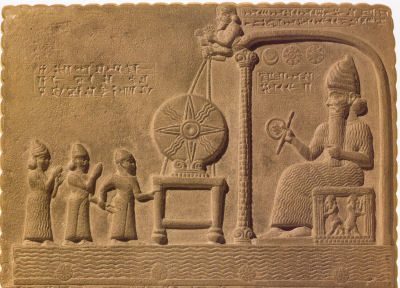 Photo Credit: https://tinyurl.com/y43vwnw8
Photo Credit: https://tinyurl.com/y43vwnw8Schools were common in Sumerian culture, marking the world’s first mass effort to pass along knowledge in order to keep a society running and building on itself.
Sumerians left behind scores of written records, but they are more renowned for their epic poetry, which influenced later works in Greece and Rome and sections of the Bible, most notably the story of the Great Flood, the Garden of Eden, and the Tower of Babel. The Sumerians were musically inclined and a Sumerian hymn, “Hurrian Hymn No. 6,” is considered the world’s oldest musically notated song.

If you find this article fun and interesting and you decide to expand on this story, using the Anzu in your work- let me know about it in the comment section below, and as usual…happy writing!
The Easter Sleuth- A Short Story for KIDS
 Photo Credit: https://tinyurl.com/yydwvb2n
Photo Credit: https://tinyurl.com/yydwvb2nThe Easter season began and Grandmama was selling off our belongings. Our sleepy Iowa town sold corn and gossip by the bushel but didn’t have a lot of room for old jazz musicians like Grandmama was. It was the 1950’s.
We were the talk of the town, and not in a good way since our parents died in a violent, submerging car crash. Grandmama moved in to “help.” She was my mama’s mama and she was an emotionally cruel woman who resented being anything but stylish, talented and pampered. “I used to play to full crowds.” She would say and she could see them there in front of her…her adoring fans. When she came back to reality, all she would see was us. The dishtowel over her shoulder seemed to remind her that she was a domestic caretaker now and she’d crack it in the air like a whip when she saw us. Her brown eyes turning black with disgust.
Then she’d day something fresh like, “What are you kids still doing here,” and she would say it with a cruel chuckle. “Quit acting like you are a spy, Johnny. You’re not 007, you’re nothing but a nuisance. I’m too young to be taking care of kids again.” Grandmama adjusted her finger waves with long manicured fingers in the mirror.
She could be a professional piano player in town instead of volunteering at church like she did sometimes. Maybe she was scared she wasn’t good enough, we didn’t know. She also could teach piano lessons or something instead of selling our parents’ things for money. She had options, but she didn’t like any of them.
Grandmama could play that piano and make it sing! But it didn’t bring her an ounce of joy, and so it didn’t bring anybody else any joy neither. There was a dullness in her movements. There was nothing but coldness in the places where love should have been.
“I know you took mama’s broaches. I followed you to the pawn shop.” I said to her boldly one morning. She stared at me long and hard, but she didn’t do anything.
 Photo Credit: https://tinyurl.com/y3y3s239
Photo Credit: https://tinyurl.com/y3y3s239“You look just like my husband who went missin’ after he went off to the war in 1942. Anyone ever tell you that, Johnny? Your granddaddy was the love of my life, but he went off and ain’t nobody ever seen him since.” She jazzed the piano keys a little and took a swig of her sugary coffee, slamming down mama’s good china. Then she inspected it closely as if she had over looked its value, and looked at me… irreverently slamming down the piano lid.
“I know he’s still alive too…I can feel it in
my bones. Clean this mess up.” Grandmama said as she sauntered away from the oak
breakfast table. She was wearing my mother’s favorite dress. The beautiful one
with the embroidered red roses. I couldn’t help it, I could excuse everything
else, but the dress? It made my blood boil. The next morning, I found it rolled
up at the bottom of grandmama’s hamper and I took it in to be cleaned and
pressed. I then took it to the charity where my mother used to volunteer. They
collected beautiful clothes for women who needed a second chance in life. She
would have wanted them to have it.
“You are a sweet boy, Johnny.” The charity lady said. “Your mother was very proud of you and I know she would have been very happy you did this…I know just the lady it will fit too.” I walked home happily. Smelling the flowers and noticing the leaves blowing on the trees. I took a breath of the fresh Iowa air and I felt mama. She was all around me, hugging me through the wind. I cried a little bit, but no one saw me.
 Photo Credit: https://tinyurl.com/y3zurz3e
Photo Credit: https://tinyurl.com/y3zurz3eI was only 12 years old the year my parents died and when the magic started. I had this incredible chance encounter with the Hare-man, at Easter, at the height of my sadness. At that time, I thought it all a coincidence, but now I’m not so sure.
I was up late reading by flashlight, and I saw the enormous creature speed through a freestanding portal out in the field. It was Easter’s Eve and suddenly his motorcycle skidded wildly, sending loose dirt raining down my window. It scared me.
I panicked and peeked…intrigued to see a steam powered motorcycle parked. The larger than life creature, a tall dapper Rabbit adjusted his spectacles and waistcoat. He whispered something inaudible.
Fairies brought three, beautiful baskets, through an opening they made in the side of our little blue house. Our place immediately filled with the scent of sage and citrus and was infused with an overwhelming sense of joy. I noticed the feeling right away because the atmosphere was suddenly light and buoyant and took the place of a heavy, melancholy sadness. Flowers started growing in my room. Vines twirled out of the walls and gorgeous blooms busted through, sending plaster and white paint flying everywhere.
 Photo Credit: https://tinyurl.com/y53wss3e
Photo Credit: https://tinyurl.com/y53wss3eThe creature was a bunny on top but had human legs. I became petrified at the impossibility of it all and dropped the flashlight. It rolled the length of the floor, stopping with a thud at the wall. I sensed him pressing his ear to the house, and I pressed my ear too and heard him breathing. It wasn’t the sound of a docile bunny and my knobby knees knocked together in fear.
“Bunny?” I said through the wall.
“Johnny, take care of your sister and your Grandmother
and find Lenny…” I heard him say.
“Who is Lenny?” I asked the void. The creature
wasn’t standing there anymore.
His name was the Hazamann. My father explained to me when I was small. His name meant “Hare-man in German. He’s what most people call the Easter Bunny.” My father knew this because the whole notion of the creature came from Germany to Pennsylvania with Immigrants in the 1700’s and my father himself was a white German Immigrant.
I couldn’t believe what I was hearing out there. The huge rabbit beast was retreating, the entire encounter lasted three minutes tops, but it changed my life forever. The vines, flowers and foliage withdrew into the walls and were gone, like nothing had even happened. Some of the peace stayed though, which is a mystery to me.
 Photo Credit: https://tinyurl.com/y3l835fq
Photo Credit: https://tinyurl.com/y3l835fqMy mama had been the real magic in my life when I was a boy. I remember her reading me
the James Bond novel, CASINO ROYALE the year she died, it was 1953.
I adored mama. She smelled like home, like baby powder and Oxydol soap and was loving and kind. We were all alone without her, my sister Hattie and me. That old red covered bridge just couldn’t carry the weight of them and fell, cascading the black car, our loving parents, our family puppy “Night time,” and the romantic picnic down into the raging waters below.
“Johnny!” Hattie yelled. She must have heard the Hazamann’s motorcycle
too. We never woke up on Easter’s eve.
I wondered if he revved the engine on purpose to wake us up as he rode back
through the portal door.
“Shhhh, you’re going to wake Grandmama up
with your carrying on.” I said to Hattie. She came to my side of the room. We pressed
our ears to the wall in unison. “See, I think he’s leaving.”
 Photo Credit: https://tinyurl.com/y3wpchxo
Photo Credit: https://tinyurl.com/y3wpchxo“I’m scared.” Hattie said. She was only 6, so I didn’t make her feel bad for being a scaredy-cat. “It’s ok, I’ll protect you, I’m 007, remember, just like mama used to say?” It calmed her.
“I wish Mama could see this.” Hattie said to me as we watched the portal disappear into thin air. A few magical sparkles were all that were left, and she smiled from ear to ear with excitement.
By the next Easter, LIVE AND LET DIE, the next
in the Bond series had been released and a copy was in my Easter basket. The
pages smelled so crisp and new. I received spy accessories to accompany my book
and Hattie got a new puppy.
“I’ll name him ‘Night’ since he’s black as my other doggie used to be…he’s a German Shepherd Johnny. He can help us find your bad guys! Things are going to get much better now, I just know it.”
 Photo Credit: https://tinyurl.com/y26prpbh
Photo Credit: https://tinyurl.com/y26prpbh“I think so too.” I said, wiping my eyes. “What else did you get?” Both of us stopped as Hattie lifted it up. A new bottle of mama’s perfume. Hattie sprayed it into the air, and we took it in hungrily. Nostalgia and love poured into us from our eager little noses to our dancing, happy feet. Grandmama watched us and smiled with a lost sense of joy. She recognized the smell too and she started to cry.
“Look kids, I know I haven’t been the best Grandmama
to you, but I am going to try. I bet you didn’t know that your Grandmama could
cook?”
“I thought all you knew how to do was eat.”
Hattie said since she had been the one making all the sandwiches since mama had
gone.
“Well, I suppose I deserve that. Today is as good a day as any to show you how it’s really done. They don’t need me at church till 2pm.” She said and she started to cook. It was Easter and she was really getting into the spirit of it. She cooked and cooked and cooked. The house was filled with sweet and savory smells and there was music playing and laughter in the air and then suddenly a knock at the door.
Grandmama answered it.
“Rose.” An older man standing at the door said
and took his hat off, lowering his eyes.
“Lenny, is that you?” Grandmama dropped the
kitchen towel she was holding and ran up to the man. He dropped his hat and
they embraced.
“…But I haven’t seen you in 10 years. I was
afraid that you were killed in battle…or worse, ran off and found you another woman.”
“Johnny found me, Rose…for the life of me, I
don’t know how, but he did and now here I am.” Lenny smiled. I didn’t think you
wanted me…you were a big jazz star and I was nothin’ but a soldier, too proud
to come on back home after the war ended.”
“Did you do this Johnny?” Grandmama said.
“Yes, it wasn’t as hard to find him as I
thought. You can find just about anything at the library. Mama taught me that.”
I said.
 Photo Credit: https://tinyurl.com/y2qadllk
Photo Credit: https://tinyurl.com/y2qadllk“She was always a smart one, my Imogene.” Lenny said, hanging his head again. He started to cry, great big crocodile tears. Maybe because he was so glad to be found. Maybe because his baby girl had died. I wasn’t sure, but there was love in our house again that morning. We sang and we ate, and we accompanied our grandparents to church where Lenny was welcomed with hardy slaps on the back by familiar faces. Grandmama was on the piano. Honestly, I didn’t know what awakening happiness looked like…but I saw it that day. She had come back from the dead that morning. She had a twinkle in her eye. Joy poured from her fingers and we all felt it.
November 24, 2020
The “Devil’s Interval” & the ancient Solfeggio scale
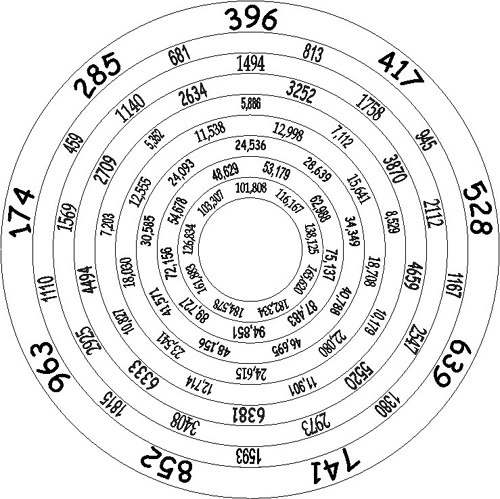 https://tinyurl.com/y2b2cld8
https://tinyurl.com/y2b2cld8According to Mental Floss, music is that powerful thing that can raise our spirits, carry us through athletic pursuits, or make us weep. Its very fabric is a source of power and intrigue, too, since just a measly few tones can do anything from shatter glass to manifest the Devil’s Tritone.
The Devil’s Tritone or the Devil’s Interval, diabolus in musica, is a combination of tones that has led to some of the most chilling melodies in music history, from classical compositions to heavy metal riffs.
As much as it’s inspired composers to explore the dark side in music, however, the Devil’s Tritone—a.k.a. the diminished fifth—also has a stirring effect on audiences for some very technical reasons. Some say that the devil’s in the details, and if you listen closely, you’ll indeed spot the Devil’s Tritone giving a certain edge to many popular tunes from different genres. It heats up Busta Rhymes’s “Woo Hah!! Got You All In Check,” the theme songs to The Simpsons and South Park, and West Side Story’s “Maria.” It also gives Jimi Hendrix’s “Purple Haze” its signature sting. It’s a favorite among metal bands, too, and can be found in any number of Black Sabbath songs (though guitarist Tony Iommi told BBC News that he simply used “something that sounded right … really evil and very doomy,” and that he “didn’t think [he] was going to make it Devil music”). Prog-rocking Rush even manages to shred its way through both ascending and descending tritones multiple times in its four-and-a-half minute, decidedly epic song “YYZ.”
According to NPR, in music theory, it’s called the “tritone” because it’s made of three whole steps.
“The reason it’s unsettling is that it’s ambiguous, unresolved,” says Gerald Moshell, Professor of Music at Trinity College in Hartford, Conn. “It wants to go somewhere. It wants to settle either here, or [there]. You don’t know where it’ll go, but it can’t stop where it is.”
There used to be rules against writing music that contained this interval. Moshell says that during the Renaissance, all music had one purpose: to be beautiful and express the majesty of God. Anything otherwise was studiously avoided. But once music was no longer shackled to the church, it was free to express all kinds of tension. The devil’s interval was ideal for that.
The higher vibration of the scale
According to buddhistdoor.net, ancient mystics, sages and scientists have long agreed upon the idea of our physical universe originating from the vibrational energy of sound.
Throughout the history of civilization, many ancients, shamans, and indigenous peoples have used sound, color, and visuals for healing, accessing altered states of reality, and transpersonal consciousness. This includes chants and of course drumming, with its neurologically stimulating beats that typically help manipulate the brain state of a practitioner and, in many cases, enable a trance state. Check out the ancient Aztec death whistles here.
According to buddhistdoor.net, In later centuries, music was organized into what we term the seven-note diatonic musical scale. Between the 10th and 13th centuries in Europe, polyphonic Gregorian chanting was the in thing—that was until an Italian Benedictine monk named Guido d’Arezzo (c. 991–c. 1050) decided to economize. He introduced the concept of solmization—attributing specific syllables to each note. Guido introduced six core frequencies, and a seventh was added later. This came to be referred to as the Solfeggio scale. Of course, the concept was not isolated to Europe. As it turns out, Durr-i-Mufassal is the Arabic solmization system, possibly improved on from ancient Greece. Sargam is the ancient Indian version.
 The affect of audio vibrations on water crystals. https://tinyurl.com/yx93vfhq
The affect of audio vibrations on water crystals. https://tinyurl.com/yx93vfhqFrequency correlation in sound light & color
The English mathematician and physicist Sir Isaac Newton (1642–1727) associated the seven solfège syllables with the seven colors of the rainbow, and surmised that each color vibrated accordingly. Thus, red has the lowest vibration frequency while violet has the highest frequency. Read about Chakras here.
 https://tinyurl.com/y2arad43
https://tinyurl.com/y2arad43The jury seems to be out (to a degree) on the efficacy of solfeggio frequencies for healing—for example, there is dispute regarding the fixed-tone healing effects of a solfeggio frequency, and the parallels in relation to the time-frequency uncertainty principle of quantum physics—but via scientific knowledge of quantum coherence, and by extension “cymatics” (geometry through vibration), there is a growing body of evidence that seems to support the influence of sound on physical health—as well as emotional and spiritual health. Because sound energy has a demonstrable effect on matter.
Frequency creates form. The below image illustrates an experiment of sound, scaling the octaves, and its subsequent effect on matter—salt in this case. A good sprinkling of salt is poured onto a flat surface above a loudspeaker. No surprise, the salt moves as the sound is played. The surprise is how the salt “jumps” into complex geometric patterns at each pitch. A similar phenomenon can be observed with water. Resembling snowflakes, matter behaves according to the frequency of the sound. This is known as cymatics; geometry through vibration.
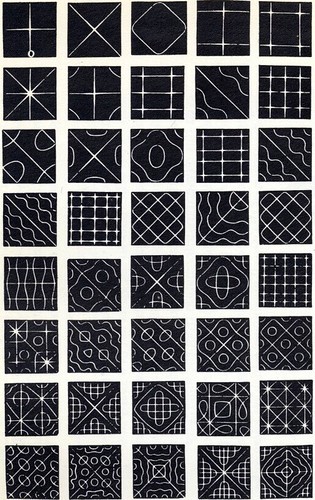
Images of Sound Frequency on sand. https://tinyurl.com/y5qrtwwe
High Vibrational music used to be the norm in classical music because it was a way to give glory to the heavens. The Catholic church even banned the Devil’s interval or the tritone for some time.
If you find this article fun and interesting, let me know your thoughts in the comment section below, and as usual…happy writing!
November 23, 2020
The ‘Aztec Death Whistle,’ artifact of religion or of psychological warfare?
What was the whistle used for?
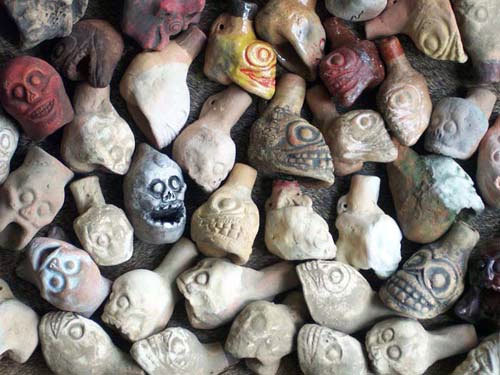 Photo Credit: https://tinyurl.com/y6ovs6as
Photo Credit: https://tinyurl.com/y6ovs6asThe Aztec death whistle was most likely used as a spiritual conduit of sorts during religious practices and was also used (it’s widely believed) as a form of psychological warfare. It was probably used to terrify Aztec and pre-Columbian foes on the battle field.
The German Music Archeologist, Arnd Adje Both is credited as the man who first blew on the artifact in the 90’s. The video above is what made the whistle part of the mainstream consciousness.
This ‘whistle’ however, belongs to the mysteries of the Aztecs and other Mezo-American cultures, because truth be told, we don’t know much about it.
Where was it discovered?
The whistle was first discovered in the 90’s by modern archeologists, within the crossed arms of a man sacrificed to the Aztec god of the wind, Ehecatl.
The remains were laid ceremoniously in front of the temple of Ehecatl in Tlatelolco. The death ‘whistle,’ discovered was dual sided, and had death represented on one side and wind represented on the other.
The artifact is referenced by Salvador Guilliem Arroyo in 1999, and is the only ancient death whistle to be documented within an archaeological context. This leaves the subject of the Tlapitzcalzin (death whistle) open to debate. It raises more questions than we have answers. Let’s start with a bit of who’s who in the Aztec world and how they were associated.
 Remains and dual sided whistle found at Tlatelolco Photo credit: https://tinyurl.com/y6xlgsjb
Remains and dual sided whistle found at Tlatelolco Photo credit: https://tinyurl.com/y6xlgsjb According to Wikipedia, In Aztec mythology, Ehecatl (“wind”) was just one aspect of the god Quetzalcoatl. His name in the Nahuatl language means “feathered serpent” or “Quetzal-feathered Serpent”. The earliest known documentation of the worship of a Feathered Serpent occurs in Teotihuacan in Mexico, within the Late Preclassic to Early Classic period (400 BC – 600 AD.) Veneration of the god appears to have spread throughout Mesoamerica by the Late Classic period (600–900 AD). Quetzacoatl, according to thoughtco, was a creator god, also associated with the planet Venus. Quetzalcoatl was the patron god of the arts and of knowledge. He was one of the most human-loving of the gods in the Aztec pantheon. He was the god who met with an ant to provide humans with their first maize to plant, and he was responsible for saving all humanity at the beginning of the Fifth Sun.
 Quetzalcoatl Ehecatl Photo Credit: https://tinyurl.com/y5h4zy9f
Quetzalcoatl Ehecatl Photo Credit: https://tinyurl.com/y5h4zy9f The pre-Columbian people believed that the god’s breath (Ehecatl) moved the sun and pushed away rain. Other times they wanted rain and would sacrifice to Tlaloc to summon this rain god’s favor.
Legend says that Ehecatl (wind) fell in love with a human girl named Mayahuel, and gave mankind the ability to love so that she could return his passion.
But the Aztecs believed in death (sacrifice,) so that the humans could preserve the relationship with the gods and ensure that life as they knew it, would keep on going. The sun (god Huitzilopochtli) would rise another day.
Not an actual, ‘whistle’
The death whistles themselves, according to Roberto Velázquez Cabrera, the founder of the Mexico City-based Instituto Virtual de Investigación Tlapitzcalzin (death whistle), the extraordinary ‘death whistle’ wasn’t a whistle at all.
It was exclusively used in several zones of ancient Mexico and belongs to a very unusual family of Mexican resonators that are not well known and which can produce special sounds imitating animal calls or the noise of the wind or storms.
Roberto Velázquez Cabrera
*It is therefore not a common whistle nor a musical instrument. We will use the term throughout, however for the sake of continuity.
‘Wind and Death’ were known ‘associates’
Roberto Velázquez Cabrera also suggests in his writings on the subject, which can be found here, that the death whistles in addition to Ehecatl, were associated with (death) or the death god Mictlantecutli, which is why a skull or owl (death totem) would have been used symbolically, but the whistle made the sound of the wind. Death and wind were associated with each other (Borgia Codex snippet pictured below.)
 Wind and Death Back to Back – Borgia Codex Photo Credit: https://tinyurl.com/y2pve4cd
Wind and Death Back to Back – Borgia Codex Photo Credit: https://tinyurl.com/y2pve4cd The only other reference to the possible ancient use of this type of whistle comes in the form of a literary reference rather than archeological. In the book, ‘Myths of Mexico and Peru,’ by Lewis Spence you can find the following text:
“The most remarkable festival in connection with Tezcatlipoca was the Toxcatl, held in the fifth month. On the day of this festival a youth was slain who for an entire year previously had been carefully instructed in the role of victim… He assumed the name, garb, and attributes of Tezcatlipoca himself… [as] the earthly representative of the deity…. He carried also the whistle symbolical of the deity [as Lord of the Night Wind], and made with it a noise such as the weird wind of night makes when it hurries through the streets.” (Lewis Spence, Myths of Mexico and Peru, London, 1913, pp. 69-70).
Playing in harmony
According to Roberto Velázquez Cabrera, more research needs to be done on the effects of the death whistle sound especially when more than one are played in unison.
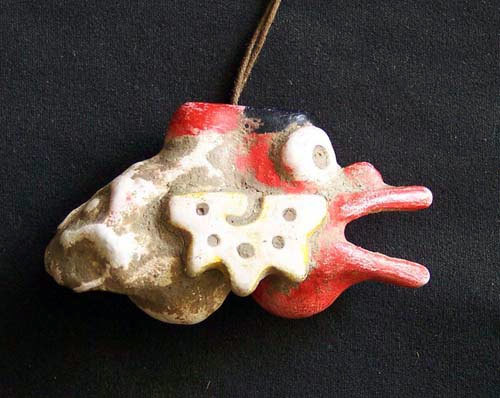 Dual sided Death Whistle Photo Credit: https://tinyurl.com/yyt2jex4
Dual sided Death Whistle Photo Credit: https://tinyurl.com/yyt2jex4“For example, we know that when two or more similar ancient whistles or their models are played at the same time, special effects can be produced, due to the vibrations generated or ‘phantom’ sounds. If the beats are ‘infrasonic’ (too low for the human ear to detect) they may alter states of consciousness. Several death whistles played at the same time can generate very complex vibrations, because their noisy signals are produced in a range of frequencies and the effects on humans is significant due to the intensity and range of their main frequencies, but their effects on health have not yet been analyzed formally. An experimental dual model of the death whistle with the faces of Ehecatl and Mictlantecutli has already been used to test the possibility of the two whistles found at Tlatelolco being played at the same time. The sounds generated are similar to those of a storm. The produced frequencies are more complex and of greater intensity than those of single whistle models.”
Psychological warfare or healing?
The death whistles are widely thought to be examples of psychological warfare used by the Aztecs. Imagine hundreds or thousands of these resonators being used at once to strike fear in the hearts and minds of your enemy.
The whistles could have also been used for healing?? The video above talks more about these subjects. What about you? What do you think the whistles were used for? Let us know in the comments below and as usual, happy writing!
Mythical Creature, “the Al-mi’raj,” a horned rabbit from Arabic poetry- with writing prompt
Also checkout Jackalope, Wolpertinger, and Lepus Cornutus but the Al-mi’raj or Almiraj (Arabic: المعراج al-mi’raj) is known as a mythical beast from Arabic poetry, said to live on a mysterious island called Jezîrat al-Tennyn within the confines of the Indian Ocean. I couldn’t find much about this island…but there is a perfume, which I found interesting and is called Jezîrat al-Tennyn.
According to Wikipedia, Al-mi’raj is a large, harmless–lookingyellow rabbit with a single, 2-foot-long, black, spiraling horn protruding from its forehead, much like that of a unicorn.
Despite its docile appearance, Al-Mir’aj is actually a ferociously territorial predator known to be able to kill animals and people many times its size…with just a few stabs of its horn.
It also has an immense appetite and can devour living things several times its size without effort. Al-Mir’aj frightens other animals.
The people of the Jezîrat al-Tennyn island were so terrified of the Al-Mi’raj eating them and their livestock that they would turn to witches to ward them away as soon as they heard the Miraj was near. It was reported that only a true witch would charm the Miraj, rendering it harmless so the people could remove it from the area.
[image error]Photo Credit; http://centuriespast.tumblr.com/page/617
It is possible this myth originates from observations of the effects of any one of several diseases in rabbits that can create horn-like growths upon the bodies of animals, most commonly Fibromatosis and Papillomatosis (SPV).
Papillomatosis is the result of a virus infecting the skin, causing a large, red, swelling growth on the skin of the subject. These red marks may have appeared to be where horns broke off or were shed. Fibromatosis is a similar virus which infects the skin and causes the flesh of the rabbit to mat with hair, hardening into long, hard horn-like protrusions. Both diseases could account for the appearance of wild, fierce (with pain) rabbits with “horns” as infected specimens have been found, catalogued and are well documented.
In Pop culture
List compiled by Wikipedia
Al-Mi’raj has been occasionally featured in video and role-playing games.
Al-Mi’raj has been adapted into Dungeons & Dragons, as part of the 1st edition Advanced Dungeons and Dragons Fiend Folio.
An enemy in the Dragon Quest Series (アルミラージ … arumirāji), first appearing in Dragon Quest III, where it is a low-level monster with a sleep attack used to render players helpless while it attacks. In U.S. it has usually been renamed to “Spiked Hare,” but its name is preserved in the Game Boy Color version. Unlike the normal legendary Miraj, this Mi’raj is purple with a white horn and white cheeks. Its standard treasure is a gold and a Leather Hat. In Dragon Quest VIII, it carries Medicinal Herbs and Bunny Tails.
According to lore, at the base of a unicorn’s horn is a ruby red jewel that is the concentrated essence of its power. With this in mind, it is possible that Ryo-Ohki from Tenchi Muyo! could be a reference to Al-Mi’raj, albeit dehorned and thus not dangerous to humanity.
Getting closer to the original mythology, the Devil Bunny game series by Cheapass Games is a game about horned, super-intelligent carnivorous evil rabbits that spend their time attempting world domination via an assortment of silly means and tormenting the Humans.
[image error]Photo Credit; http://lyekka.deviantart.com/art/Al-Miraj-Ambush-332479209
– In Episode 10 of the anime game, Is It Wrong to Try to Pick Up Girls in a Dungeon? the first floor of the mid level contains multiple white rabbits that walk on two legs. Two of the main characters Lilly and Welf claim that they are the protagonist Bell Cranel due to the matching red eyes and white hair. The rabbits are then identified as al-mi’raj by Bell before being interrupted as the rabbits attack.
– The behavior of General Woundwort, the antagonist of Watership Down, and the Killer Rabbit from Monty Python and the Holy Grail might have been inspired by Al-mi’raj.
In the animated short “Red” (2010) the little wolf-boy protects Red from an Al-Mir’aj that can grow to a monstrous size, and kills it.
The Yu-Gi-Oh Breakers of Shadow booster pack has released a card based on this mythical creature called Al-Lumi’raj.
The game Rage of Bahamut (and subsequently the Shadowverse CCG which is based on it) contains a character called Moon Al-Mir’aj, a humanoid rabbit with a black horn called Ramina.
In the Donald Duck story Mythological Menagerie, written and drawn by Don Rosa, Donald tries to fool Huey, Dewey and Louie by painting a rabbit yellow and attaching a horn to it, but the nephews identify it as a the Mi’Raj
[image error]Writing Prompt-
The Mi’raj, the American Jackalope, the Wolpertingers and the Lepus Cornutus are all the same animal in this prompt. SPVirus or no, that isn’t the concern of this writing prompt. Let’s look at the parable of The four blind men and the elephant, to get a sense of what this prompt is asking you to do.
(Adapted from David A. Horner) According to everystudent.com, there is a popular analogy used to illustrate how all religions are valid in their ways of describing God, the universe or the creator.
Theological professors especially love this philosophic analogy, because it equalizes all religions, making them “omni-true” in their description of the God force.
[image error]
Photo Credit; http://unita-n.deviantart.com/art/Mi-Raj-sketch-310643074
The parable goes like this: there are four blind men who discover an elephant. Since the men have never encountered an elephant before, they grope about, seeking to understand and describe this new phenomenon.
One grasps the trunk and concludes it is a snake. Another explores one of the elephant’s legs and describes it as a tree. A third finds the elephant’s tail and announces that it is a rope. And the fourth blind man, after discovering the elephant’s side, concludes that it is, after all, a wall, a leather wall..at that!
Each in his blindness…describes the same animal: an elephant. Yet each describes the same thing in a radically different way.
According to many, and I love this sooo much…this is analogous to the different religions of the world — they are describing the same thing in radically different ways. Thus one should conclude that no individual religion has a corner on truth, but that all should be viewed as essentially equally valid.
The Mi’raj is not documented as being a benevolent, kind creature…but let’s make it one, because who is to say that it is not?
Your writing prompt is this…looking at different cultures, races, and religions, there are many legends and mythological stories which attempt to explain natural phenomena. Explain the rabbit with a horn. This is a character development prompt. Who is he or she? Why is he seen in so many cultures? If he is a divine, or at least “good,” creature…what does he bring to the cosmic, moral table?
If you find this article fun and interesting and you decide to expand on this story -let me know how it continues in the comment section below, and as usual…happy writing!
November 12, 2020
The Mythological Creatures
Good company in a journey makes the way seem shorter. — Izaak Walton
A Bao A QuAatxeAbaasyAbadaAbaiaAbarimonAbura- SumashiAcephaliAcheriAchlisAdar Llwch GwinAdaroAdheneAdletAdzeAfancAgogweAhkiyyiniAhuizotlAituAitvarasAjatarAkatekoAkhlutAkkaAkkorokamuiAl Mi’rajAlojaAlom-bag-winno-sisAlpAl RakimAlseidAluxAmaburakosagiAmarokAmemasuAmmitAmphiptereAmphisbaenaAnakimAnansiApsaraAntaeusAnzuArionArkan Sonney
October 11, 2020
Mythological Creature; the Anansi SPIDER of West Africa and the African Diaspora
The Ghanaian Anansi spider is believed to be a god, responsible for creating the sun, the stars and the moon, as well as teaching mankind the techniques of agriculture and were passed down in the oral tradition over the span of hundreds of years. The stories have survived a lot.
According to wilderutopia.com the Anansi stories are popular in the US because they came here during the African Diaspora.
The African Diaspora is the term commonly used to describe the mass dispersion of people from Africa during the Transatlantic Slave Trades, from the 1500s to the 1800s. As we know, this Diaspora took millions of people from Western and Central Africa to many different regions throughout the Americas and the Caribbean.
African food, culture and stories
[image error]Photo Credit: https://tinyurl.com/yxzsqrzg
These African ancestors landed in regions that featured local foods and cuisines, as well as other cultural influences, that shaped their unique cooking styles.
The overall pattern of a plant-based, colorful diet based on vegetables, fruits, tubers and grains, nuts, healthy oils and seafood (where available) was shared throughout these regions. Their tastes can be shared and tried by people everywhere. Here are the top ten Ghanaian specific dishes according to theculturetrip.com.
The stories came and then spread during the Diaspora too. The Anansi stories come from Ghana and are credited as being passed down from the Ashanti people (Twi). The tales spread to other Akan people too and then to the West Indies, Suriname, and the Netherlands Antilles.
Aunt Nancy
Anansi means spider in Akan and the creature is usually depicted of course, as a spider. On Curaçao, Aruba, and Bonaire he is known as Nanzi, and his wife as Shi Maria. He is also known as Ananse, Kwaku Ananse, Anancy, and in the southern US, Aunt Nancy.
Anansi is also thought to be a trickster and the West African spirit of all ‘knowledge of stories.’ He is one of the most important characters of West African and Caribbean folklore. For the story of how he gained the ‘knowledge of stories,” click here– because once…there were no stories in the world. 
September 28, 2020
Mythological Creature; The Arkan Sonney, a magical hedgehog from the Isle of Man
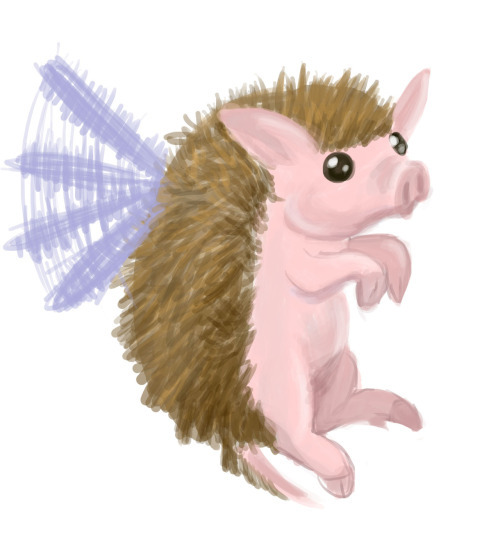 Photo Credit; https://tinyurl.com/yxzuuyyl
Photo Credit; https://tinyurl.com/yxzuuyylThe Isle of Man is one of the British Isles, located in the Irish Sea off the northwest coast of England. The Manx, as the people there are called, have a rich history, steeped in folklore and myth, see Adhene Fairies.
According to Wikipedia, the Arkan Sonney is a type of fairy animal which takes the form of a pig that brings good fortune to those who manage to catch it.
The Arkan Sonney are considered a favourable omen just to have seen the “lucky pig”.
It is said that if you catch one of these magical creatures you could find a silver coin in your pocket.
In Fairy Tales From the Isle of Man (1951) by Dora Broome, the white pig is described as having red eyes and ears, and though it can alter its size it is not able to change its shape.
The Manx Fairy Pig
There was once a little fairy pig that lived in the hills beyond Colby with his mother and his six brothers. His name was Shiaght, which means Seven, and his brothers were called Nane, Jees, Tree, Kiare, Quieg and Shey, which is Manx for One, Two, Three, Four, Five, Six – but Shiaght was the liveliest little pig of them all.
As soon as he was old enough his mother taught him Magic, as well as the way to curl his tail and waggle his ears, and how to keep his feet out of clover.
“Take care of your feet, that you don’t sliddher,” she said, “curl your tail from left to right, and remember you are one of the Seven Magic Pigs of the South.”
“Honk! Honk!” said the little pig, which means in pig language, ‘Yes! Yes!’
Wonderful clever the pigs were in those days, for they’d speak Manx as soon as look at you, and they’d make themselves big, and make themselves small, just as the Buggane of Barrule could do, and he was a powerful creature. All the seven brothers were white with red eyes and scarlett ears at them, the neat and tasty you wouldn’t believe!
Little Shiaght wanted to know about everything, and if he couldn’t find out in one way he’d try another. “You will do jeel on yourself one of these days,” said his mother, meaning he’d get into mischief, “you will get your nose nipped off, pokin’ it into other one’s business.”
“Honk! Honk!” said the little white pig, and he sniffed and snuffed to make sure his nose was still there.
“The oul’ ones don’t know everything,” he said to himself, “a pig mus’ see the worl’ before he can make up his mind what’s in it.”
So one day, off he went by himself, to see if the world was as big as he thought it was.
He hadn’t gone far when he met an old woman gathering sticks.
“Honk! Honk!” said the little white pig.
“Yee bannee mee!” said the old woman (which means ‘God bless me’). “What in the worl’ was that?” And she turned round and saw the little white pig eating clover.
“What are you doin’ there l’il one?” she said. “A clever l’il pig like you should be livin’ in a sty.”
“What’s a sty?” said the little pig.
“Aw, a wonderful grand place a sty is,” said the old woman, “theer’s nothin’ but atein’ an’ drinkin’, an’ you will be waited on hand an’ foot.”
“Where’s your home?” said the little pig.
“Down the lane,” said the old woman, “come with me l’il qwhite one, an’ I’ll show you.”
“Honk! Honk!” said the pig, and he followed the old woman, thinking what a grand place he was going to.
When she got him home, she shut him in the sty and fastened the gate.
“Stay there l’il masther,” she said, “you will lose yourself wanderin’ the roads.”
“I’m not thinkin’ much of this place at all,” said the little pig to himself. “Open the gate old woman, an’ let me out.”
“Let you out, indeed,” said the old woman, “you will not find a batthar sty in all the islan’ I’m tellin’ you. Wait till I bring you a basin of pig’s meat.” And away she went.
Shiaght sat down and scratched his right ear with his left hind foot, and then his left ear with his right hind foot. But things didn’t look any better.
“You have brought yourself to a pretty market, Shiaght boy,” he said, “the oul’ one is middlin’ sharp for all.”
After some time the old woman returned with a basin of meal and potato peelings. “Here’s a dish for a king, l’il masthar,” she said, “you won’t get batthar priddha peelin’s any place you are livin’.”
“Honk! Honk!” said the little pig, sniffing at the basin. “I’m not thinking much to that. A tuft of clover an’ a dish of crame would be suiting me batthar.”
“Thim that doesn’t work for their meat should take what’s given thim,” said the old woman, and she went into the house and slammed the door, thinking to herself that she’d sell the little pig in Doolish market on Saturday.
Shiaght thought and thought and the more the thought the less he liked it.
“You had batthar get out of this middlin’ quick, Shiaght boy,” he said to himself. Then he remembered that he was one of the Seven Magic Pigs and he shook himself and said the magic words his mother had taught him, and in seconds he was out on the road trotting along to Doolish.
“You will never see the worl’ from a sty, boy,” he said, “you will make nawthin’ but bacon if you stay there.”
At last he came to Doolish and strolled along the busy streets, wondering at the shops and people and the carts and carriages going up and down. He curled his tail from left to right and cocked his scarlet ears and his eyes glowed red as rubies. Soon people began to follow him, and one of them tried to lay hold of him but the little pig turned, with his eyes like fire, and the man let go in a hurry.
“I’m thinkin’ these ones haven’t see a Magic Pig in Doolish,” said Shiaght, and he walked along, picking his steps, and sniffing and snuffing all the way.
“Wonderful clivar you are boy,” said a big man in uniform, who was standing in the middle of the road, “will you come with me, an’ I’ll show you the sights of Doolish?”
“Is theer a sty at thee?” said the little pig.
“Deed no,” said the man, “’tis a grand room I’ll be showin’ you, that’s fit for the like of you.”
“Honk! Honk!” said the little white pig. Off they went with the little pig following him and – what do you think? – he shut the pig in the police station!
Now Shiaght was in a worse fix than ever. If a sty had been hard to get out of, a prison cell was harder.
“Is this what you are callin’ a grand room?” said Shiaght, sitting down in the middle of the cell and scratching himself. “Well, well Shiaght boy, you are in a hole right enough, but you will get to the top with scratchin’ as the mole said, before now.”
And with that, he began to blow himself up bigger and bigger, till he filled the whole of the cell. Then the door gave way and he burst out, scattering policemen right and left, and into the street, where he was nearly as big as a balloon. What a running and shouting there was!
“Fetch the fire-engine!” cried one, and “Stop the road at the end,” cried another, but though they talked so much nobody was brave enough to do anything.
As soon as he got out of Doolish, Shiaght shook himself, and he grew smaller and smaller till he was only a little pig, trotting along the road to Snaefell.
“Terrible bad ones theer are in the worl’,” he thought, “you are needin’ a bit of magic to deal with thim.”
He came at last to the foot of Snaefell. “I wonder would it be cold up theer?” he said, ‘an’ would there be clover at me?”
Soon he was climbing the mountain, but never a tuft of clover could he find, only stones and rough grass, and he began to be very hungry. Soon he met the Wizard of the mountain, who had a wonderful palace up there.
“Moghrey-mie, l’il pig,” said the Wizard. “Good morning to you. Where are you goin’ this fine day?”
“I’m goin’ through the worl’ with me nose before me,” said the little pig.
“Your nose will get you into trouble one of these days,” said the Wizard, “you had batthar come to my castle an’ eat an’ drink before you go further.”
“Is there a sty at thee?” said Shiaght. “Or a room where you will shut me up? For I’m not likin’ thim places at all.”
“You can walk the palace through an’ come out when you want,” said the Wizard. “Theer’s nothin’ to keep you, if you don’t poke your nose where it isn’t wanted.”
“Gur-eh-mie-eu,” said Shiaght, which is Manx for ‘thank you,’ and they walked on, to the top of the hill.
A fine castle indeed it was and filled with ladies and gentlemen in fine clothes, eating and drinking and laughing; with music playing, and fountains splashing into marble basins. Shiaght ate and drank with the best of them, till at last he was tired and lay down and slept. When he woke there wasn’t a soul in the palace but himself. The lights blazed and the tables were spread, but everything was silent.
“There’s quare doin’s in here,” said the little pig, and he sniffed and snuffed all round, from top to bottom of the palace. “I’m thinkin’ there’s magic in somewhere.” He sat down to scratch his left ear with his right foot, when all at once he noticed a little paper packet tucked away in a corner of the kitchen shelf – for it was the kitchen he’d reached on his travels.
“What’s this at all?” said Shiaght, nosing the packet. There was some writing outside but although he’d learned magic, he’d never learned to read.
‘DON’T OPEN,’ it said, but Shiaght didn’t know that. So he sniffed and he snuffed and tore the paper open.
“Whoof!” he said. “Nothin’ but salt.” And he blew the salt away with a great sneeze.
The same instant there was a terrible roar and a blaze, and up went the whole place in flame and a flash of lightning. And the little pig found himself standing on the top of Snaefell with his four legs square to the wind and his eyes blinking from the flame. And not a sight nor sound of the fine castle, the lords and ladies or the Wizard himself, but only the mists coming down on the hill.
“You have done jeel sure enough, boy,” said Shiaght, “you batthar get out of this.”
And away he went, as fast as his legs could carry him and he never stopped till he came to his mother and his six little brothers at Colby.
“Have you seen the worl’ Shiaght?” they said. “An’ is theer fine atein’ an’ drinkin’ in it?”
“Middlin’, middlin’,” said Shiaght, “an’ theer’s some middlin’ sharp ones too.”
“Didn’t I tell you to keep your nose out of mischief?” said his mother, “an’ never put salt on magic?”
“Honk! Honk!” said the little pig, and he looked at his brothers. “If you can’t keep your nose out of mischief,” he said, “you are batthar to stay at home.”
“You are sayin’,” said his mother. And when Shiaght wasn’t looking she put a laugh out of her, into the clover.
(source: Fairy Tales from the Isle of Man by Dora Broome (1951); photograph (with
embellishment)
If you find this article fun and interesting and you decide to expand on this story, using the Arkan Sonney in your work- let me know about it in the comment section below, and as usual…happy writing!
September 7, 2020
Mythological Creature; Arion, a green maned, divine horse from Greek Mythology
According to greekmythology.com (I’ll keep their hyperlinks so you can refer to their webpage for further research.) Arion was an immortal, talking horse in Greek mythology. He was reported to be very fast and was directly bred by the gods.
 Photo Credit: https://tinyurl.com/yy57j9uu
Photo Credit: https://tinyurl.com/yy57j9uuSources differ on how the horse came into being. Some say that he was foaled by the goddess Demeter after laying with Poseidon, while others say that he was born of the goddess of Earth, Gaea, herself.
Its most notable owner was Adrastus, king of Argos. Arion is also mentioned in the myth of Heracles against the Eleans, in which the demigod took the stallion from Oncus. He then rode on Arion during the war, and gifted it to Adrastus afterwards. During the battle of the Seven Against Thebes, in which the brothers Eteocles and Polynices killed each other while vying for the Theban throne, Adrastus was the only attacker to survive thanks to Arion‘s intervention.
Wikipedia says that Arion means “moon-creature on high,” and goes on to talk about the Mythology and literary references of the famed divine horse. I’ve included them below.
The earliest literary mention of Arion is in Homer‘s Iliad (Book XXIII, ln. 346). Statius also made mention of the horse in his 1st-century Latin epic poem the Thebaid (Book VI, 301).
Homer
 Photo Credit: https://tinyurl.com/y33oukwl
Photo Credit: https://tinyurl.com/y33oukwlOn the subject of Arion, Homer said in the Iliad: “… there is no man that shall catch thee by a burst of speed, neither pass thee by, nay, not though in pursuit he were driving goodly Arion, the swift horse of Adrastus, that was of heavenly stock…”
Pseudo-Apollodorus
Pseudo-Apollodorus (Book III, Ch. 6, sect. 8) recounts that in the defeat of the Argives, the same battle in which Eteocles and Polynices slew each other, Adrastus alone among the Argive leaders survived, saved by his horse Arion that Demeter, in the likeness of a Fury, had conceived by Poseidon. The scholiasts of the Iliad (XXIII, 347) and of Lycophron (153) attribute to him the same origin.
Pausanias
Pausanias says: “Demeter, they say, had by Poseidon a daughter, whose name they are not wont to divulge to the uninitiated, and a horse called Areion. For this reason they say that they were the first Arcadians to call Poseidon Horse.”
 Photo Credit: https://tinyurl.com/y6798u63
Photo Credit: https://tinyurl.com/y6798u63In support of the lineage they advance, Pausanias reports, the Arcadians cite some verses from the Iliad (23.346 quoted above) and the Thebaid (an early Greek epic of uncertain authorship, of which only fragments remain). Pausanias says that “in the Thebaid it is said that Adrastus fled from Thebes: ‘Wearing wretched clothes, and with him dark-maned Areion’ . Latin scholia assert that these verses indicate that Neptune was Arion’s sire. But Pausanias goes on to quote Antimachus of Colophon as saying that Arion was a child of the Earth (Gaia): “Adrastus, son of Talaus, descendant of Cretheus,The very first of the Danai to drive his famous horses,Swift Caerus and Areion of Thelpusa,Whom near the grove of Oncean ApolloEarth herself sent up a marvel for mortals to see.”
According to Pausanias, Heracles, waging war with the Eleans, acquired this horse from Oncus. The son of Zeus would have thus ridden upon Arion when he seized Elis. Thereafter, Heracles gave Arion to Adrastus; this is why Antimachus said of Arion: “Adrastus was the third lord who tamed him.”
******Check out Bulfinch Mythology -the Arion Myth here for the story of Arion and the dolphin. You can also read it here in modern speech. According to these stories, Arion was a musician!
 Photo Credit: https://tinyurl.com/y3knrnzj
Photo Credit: https://tinyurl.com/y3knrnzjArion appears in Rick Riordan‘s fantasy novel The Son of Neptune , in which he is mastered by the Roman demigod Hazel Levesque, daughter of Pluto. Hazel encounters a caged Arion in the headquarters of the Amazons in Seattle, and successfully manages to both feed and then ride him. He subsequently appears in the remaining installments of the Heroes of Olympus series. According to Percy, the horse usually ‘cusses like a sailor’.Japanese advertisements for the Mitsubishi Starion describe the name as referring to a star, and Arion.Arion is featured in Wizard101 . This version is a humanoid horse who is the son of Poseidon: Earth Shaker and the brother of Lamia. The players fight him in Atlantea within the “dungeon zone” of Aquila.
If you find this article fun and interesting and you decide to expand on this story, using the Arion in your work- let me know about it in the comment section below, and as usual…happy writing!
 Photo Credit: https://tinyurl.com/yxlwlmfm
Photo Credit: https://tinyurl.com/yxlwlmfm
August 12, 2020
Mythological Creature; the Apkallu sages- teachers of mankind
According to Livius, there is an ancient Mesopotamian myth. It was believed that the gods created humankind to cultivate the soil and make sure that the gods – by means of sacrifice – would receive their meals. However, the first people did not really understand how to perform the tasks they were supposed to perform, and therefore, the gods sent the Apkallū, the seven sages, as teachers. These creatures came to the human world from the sea.
The first one of these was Uanna, or Oannes who had not only the body of a fish, but also the feet, arms, head, and voice of a man. He explained how to read and write and how to do mathematics, but also how to build cities and temples. He taught them how to make laws, draw borders, divide land, plant seeds, and harvest fruits. Uanna also explained to the first humans how the gods had created the world.
There were other Apkallū. Each of them were associated with one of the cities of old, and they taught the people everything.
[image error]Photo Credit: https://tinyurl.com/y3dfplrt
The story of the Apkallū is told by Berossus. In the Epic of Gilgameš, they are mentioned as the builders of the walls of Uruk. They are also mentioned in ritual texts and are represented in Palace S in Pasargadae. A parallel can be drawn in Jewish apocalypticism, in which sometimes beasts are presented, coming from the sea.
*****Plaques of the Apkallū were placed in Mesopotamian houses and were believed to ward off evil. It is likely that the Greeks copied the idea, and created their seven sages after the mythological heptad.*****
[image error]Photo Credit: https://tinyurl.com/yyc6yy3d
According to Ancient Origins, One of the great riddles in Mesopotamian sacred art concerns the image of anthropomorphic winged figures Apkallu holding a mullilu (fruit) in one hand, and a banduddû — a container — in the other.
The purpose of this container is mysterious.
This container appears throughout Sumerian and Babylonian cultures, and half a world away in the Yucatan.
Six thousand years earlier, it had been carved in a relief upon Pillar 43 at Gobekli Tepe, one of the world’s oldest standing stone enclosures in Turkey.
Apkallu came after the Great Flood
The Apkallu, as previously stated, are a group of seven sages, emissaries and mediating figures entrusted by a creator god to bring the civilizing arts to humanity following a catastrophic flood (Epic of Gilgamesh).
Their story is repeated almost verbatim in diluvial myths of many ancient cultures, the only changeable aspect being their names.
[image error]Photo Credit: https://tinyurl.com/yypbf2wf
The quintessential image of the Apkallu is that of two eagles-, or perhaps falcon-headed hybrid people standing on either side of a flowering tree, picking its fruit, and the manner in which they hold the mysterious container suggests the fruit are to be placed inside. Sometimes the figure of the supreme deity Ahura Mazda is depicted inside of a winged disc which is above the axis of the tree, implying it is close to God, and thus, close to wisdom.
This is another widely shared image – known as the World Tree or the Tree of Knowledge, and served both as a focal point and a foundation of all mysteries, teachings and traditions across many faiths and traditions.
[image error]Photo Credit: https://tinyurl.com/y4rfhhg5
According to Ancient Origins, the iconic container appears on many carved panels and clay tablets found in the palace of Nimrud (an ancient Assyrian city) and its surrounding regions.
To solve the riddle of the meaning of the container, it is important to see some of the images together, because, placed in context, they appear to form a kind of triptych conveying a running commentary. Such a series of panels, removed from one of the rooms in Nimrud, is now housed in the British Museum.
One panel shows two Apkallu administering to the sacred tree; in the next, an Apkallu has turned from the tree and bestows a king with fruit, all the while holding that mysterious container.
[image error]Photo Credit: https://tinyurl.com/yyc6yy3d
The featured king is identified as Ashunarsipal, who was also a priest, a high initiate of the temple, and thus privy to secret knowledge that only such a position could allow.
We know he held this position because in a separate frieze he is depicted holding a beehive above his head, a clear indication he has been initiated into the ‘secrets of the beehive.’
In a next panel Ashunarsipal is no longer surrounded by the Apkallu, he himself has been transformed into a winged figure holding a fruit from the tree of knowledge and holding a container.
In the following image he stands in direct contact with the Tree of Knowledge and points directly at Ahura Mazda inside his solar disc.
[image error]Photo Credit: https://tinyurl.com/yyc6yy3d
Obviously the king has partaken of the fruit, and the knowledge it contains has transformed him into an Apkallu, allowing him direct access to God. Does the container represent the soul…the mind…the eternal spirit?
What do you think?
If you find this article fun and interesting and you decide to expand on this story, using the Apkallu in your work- let me know about it in the comment section below, and as usual…happy writing!



